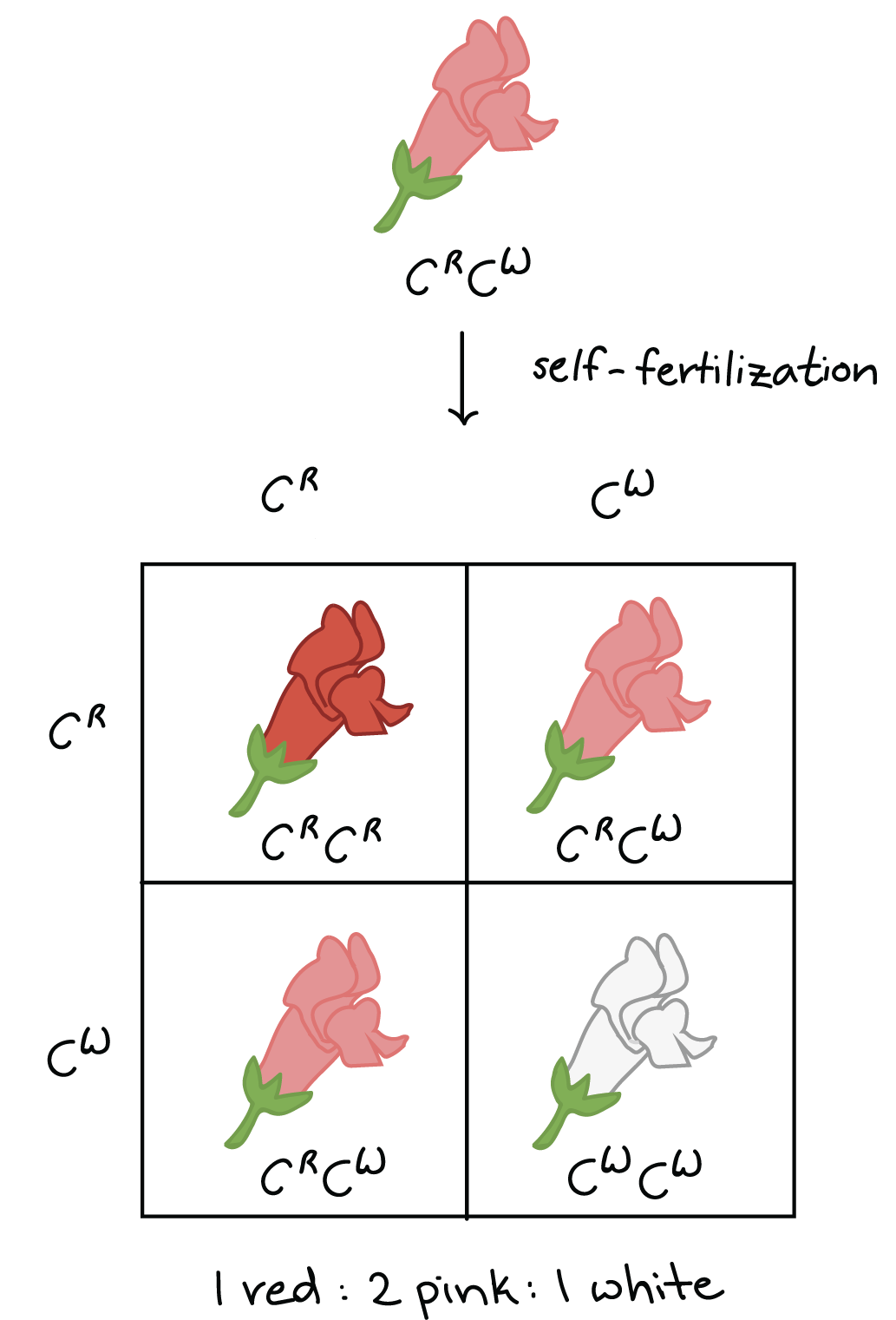- Mendelian inheritance patterns involve genes that directly influence the outcome of an organism’s traits and obey Mendel’s laws.
- Most genes in eukaryotic species follow a Mendelian pattern of inheritance. However, there are many that do not.
- Non-Mendelian inheritance is a general term that refers to any pattern of inheritance in which traits do not segregate in accordance with Mendel’s laws. These laws describe the inheritance of traits linked to single genes on chromosomes in the nucleus.

Interesting Science Videos
1. Codominance
- Codominance is believed to be a violation of the Law of Dominance.
- When the alleles for a particular trait are co-dominant, they are both expressed equally rather than a dominant allele taking complete control over a recessive allele.
- This means that when an organism has two different alleles (i.e., is a heterozygote), it will express both at the same time.

Example.
Speckled flowers where the plant breeder has bred two different colors of flower together, resulting in a speckled hybrid that has patches of color from both parents.
2. Incomplete Dominance
- Sometimes in a heterozygote dominant allele does not completely mask the phenotypic expression of the recessive allele and there occurs an intermediate phenotype in the heterozygote. This is called incomplete dominance.
- With co-dominant alleles, both traits are expressed at the same time. With incomplete dominance, the same thing occur but the traits are blended together rather than occurring in discrete patches.
- It thus refers to the condition in heterozygotes where the phenotype is intermediate between the two homozygotes.

Example.
In some plants the cross of red and white produces pink-flowered progeny (Four-o’clock plants (Mirabilis jalapa) or snapdragons (Antirrhinum majus).
3. Polygenic Inheritance
- Some traits are controlled by many genes such as the height, IQ, skin color, eye color etc.
- Polygenic inheritance occurs when one characteristic is controlled by two or more genes.
- Often the genes are large in quantity but small in effect.

Example. Skin Colour in Man
Davenport (1913) in Jamaica found that two pairs of genes, A-a and B-b cause the difference in skin pigmentation between negro and caucasian people. These genes were found to affect the character in additive fashion.
Thus, a true negro has four d o m i n a n t genes, AABB, and a white has four recessive genes aabb. The F1 offspring of mating of aabb with AABB, are all AaBb and have an intermediate skin colour termed mulatto. A mating of two such mulattoes produces a wide variety of skin colour in the offspring, ranging from skins as dark as the original negro parent to as white as the original white parent.
4. Multiple Alleles
- Mendel studied just two alleles of his pea genes, but real populations often have multiple alleles of a given gene.
a. An example is ABO blood type in humans.
There are three common alleles for the gene that controls this characteristic. The alleles IA and IB are dominant over i. A person who is homozygous recessive ii has type O blood. Homozygous dominant IAIA or heterozygous dominant IAi have type A blood, and homozygous dominant IBIB or heterozygous dominant IBi have type B blood. IAIB people have type AB blood, because the A and B alleles are co-dominant. Type A and type B parents can have a type AB child. Type A and type B parents can also have a child with Type O blood, if they are both heterozygous (IBi, IAi).
Type A blood: IAIA, IAi
Type B blood: IB IB, IBi
Type AB blood: IAIB
Type O blood: ii

b. Another example is the gene for coat color in rabbits (the C gene) which comes in four common alleles: C, cch ch, and c.
5. Pleiotropy
- Some genes affect many different characteristics, not just a single characteristic.

An example of this is Marfan syndrome, which results in several symptoms (unusually tall height, thin fingers and toes, lens dislocation, and heart problems). These symptoms although not seem to be directly related, can be traced back to the mutation of a single gene.
6. Gene Linkage
- Each chromosome contains more than one gene.
- If the genes are situated in the same chromosome and are fairly close to each other, they tend to be inherited together.
- This type of coexistence of two or more genes in the same chromosome is known as linkage.

For example, some combinations of wing shape and body color are inherited together. Fruit flies that have brown bodies are more likely to have normal wings, while fruit flies that have black bodies are more likely to have vestigial wings.
7. Extra-nuclear Inheritance
- Though, the genes of nuclear chromosomes have a significant and key role in the inheritance of almost all traits from generations to generations, they altogether cannot be considered as the sole vehicles of inheritance.

- Certain experimental evidences suggest the occurrence of certain extranuclear genes or DNA molecules in the cytoplasm of many prokaryotic and eukaryotic cells. For eg. Mitochondria and chloroplasts have their own DNA and reproduce on their own inside each cell.
- Mitochondrial DNA is passed down from a mother to her offspring because the mitochondria in sperm cells don’t make it into the egg. Thus, the entire mitochondrial DNA in the offspring —whether male or female—originally comes from the female parent only.
References
- Verma, P. S., & Agrawal, V. K. (2006). Cell Biology, Genetics, Molecular Biology, Evolution & Ecology (1 ed.). S .Chand and company Ltd.
- Gardner, E. J., Simmons, M. J., & Snustad, D. P. (1991). Principles of genetics. New York: J. Wiley.
- http://www.untamedscience.com/biology/genetics/non-mendelian-genetics/
- https://www.khanacademy.org/science/high-school-biology/hs-classical-genetics/hs-non-mendelian-inheritance/a/hs-non-mendelian-inheritance-review
- https://www.ck12.org/biology/non-mendelian-inheritance/lesson/Non-Mendelian-Inheritance-BIO/
- http://www.tusculum.edu/faculty/home/ivanlare/html/genetics/nonmendel-master.html
